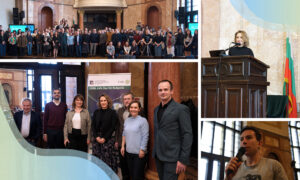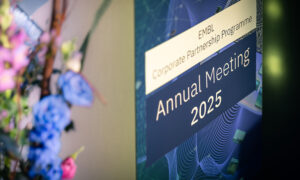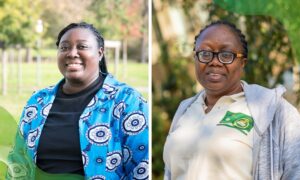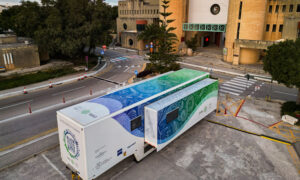
EMBL Barcelona celebrates EMBL’s 50th anniversary with Spanish community
EMBL’s youngest site marks the European life-science laboratory’s golden anniversary by discussing the future of tissue biology, connecting with stakeholders and top researchers, and reuniting with EMBL alumni
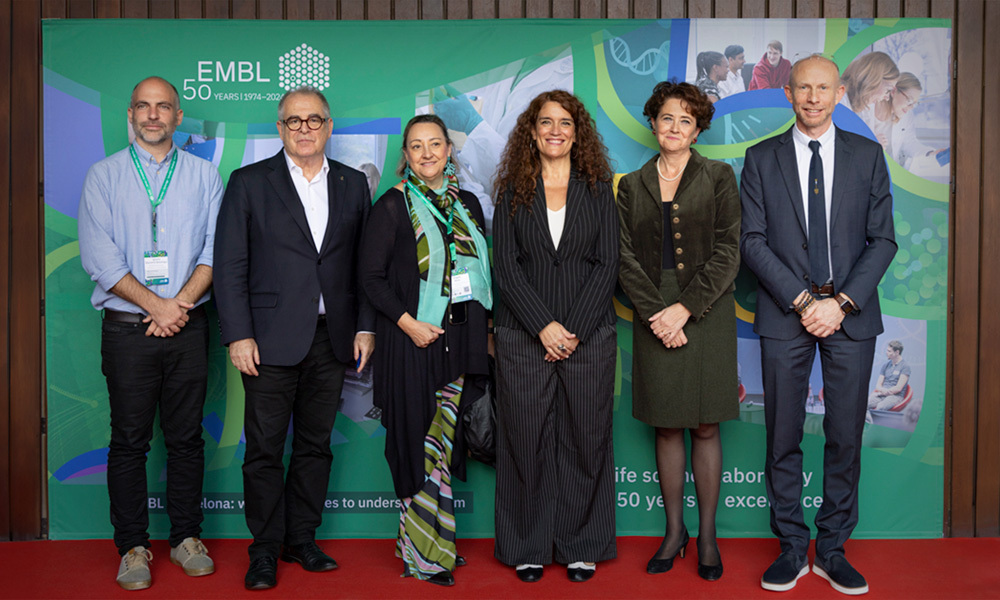
It was a celebration like so many other golden anniversaries (or Bodas de Oro, as they say in Spain): commemorative speeches, video montages, and the gathering of ‘family’ and friends…but with a scientific twist. Europe’s life sciences laboratory turned 50 this year, and its youngest research site, EMBL Barcelona, celebrated the occasion on 6 November with its own family and scientific friends to note the progress they have made together.
To celebrate these five decades of ground-breaking research, EMBL Barcelona brought together political leaders, members of the Spanish scientific community, and EMBL alumni.
Hosted by EMBL Director General Edith Heard, Head of EMBL Barcelona James Sharpe, and PRBB Director Jordi Camí, the event welcomed more than 200 people, including prominent figures such as Eva Ortega-Paíno, the Spanish Secretary General for Research and Jordi Valls, Deputy Mayor for Economic Innovation of Barcelona.
“In this celebration of EMBL’s 50 Anniversary in Barcelona, I am convinced that the coming years will bring with them new opportunities and more shared achievements that will further strengthen our collaboration.” said Ortega-Paíno. “Together, we will continue to work in order to ensure that scientific research remains a driving force for the well-being of our societies.”
“Today we celebrate EMBL’s first 50 years of success, and reflect on the exciting future ahead of us,” Heard said to guests. “Our young site in Barcelona is a hub of excellence in the field of tissue biology and disease modelling, which truly embodies EMBL’s commitment to curiosity-driven research. None of this would be possible without a strong network of partners and collaborators, whose representatives we are delighted to host at EMBL Barcelona today.”
EMBL Barcelona was founded in 2017 with the aim of understanding how tissues develop and function in health and disease. Matthias Lütolf, Head of EPFL’s Laboratory of Stem Cell Bioengineering, kicked off the event with an introduction to how tissue biology and engineering are reshaping biomedical research.
Additionally, four leading researchers from Catalan institutes gave scientific presentations: Pia Cosma from the Centre for Genomic Regulation (CRG), Spain, Xavier Trepat from the Institute for Bioengineering of Catalonia (IBEC), Eduard Batlle from the Institute for Research in Biomedicine in Barcelona (IRB), and Cristina Pujades from the Universitat Pompeu Fabra (UPF).
Several EMBL alumni also took the stage to share their personal experiences at EMBL and its impact on their scientific careers.
EMBL Barcelona: shaping the future of tissue biology
For decades, scientists have tried to understand complex animals by focusing on the smallest building blocks of life – DNA or protein ‘LEGO bricks’ and their function within cells. But in the human body, millions of cells work together to create tissues and organs and form structures with unique behaviours and properties.
“Just as you can’t simply look at individual ingredients of a cake to understand its taste or texture, one can’t understand the function of a heart just by looking at individual cells,” Sharpe said. “While each cell is important, it’s the way they interact as a group that makes the heart beat and pump blood – in much the same way that those cake ingredients combine and interact. This is at the heart of EMBL Barcelona’s work – studying this important level of organisation between cells and organisms.”
Seven years into EMBL Barcelona’s scientific journey, the Unit is doing what EMBL does best – bringing together both curiosity-driven research into the fundamental organisation of life, with biomedical questions on human diseases and the very foundations of health. The rapid development of technologies like AI, imaging techniques, and methods of creating 3D tissues is allowing researchers to move closer to generating models that replicate the complexity and function of human organs. These breakthroughs offer a new horizon to study diseases at their cellular and molecular roots, which could dramatically accelerate diagnostics and therapeutics.
Similarly, tissue engineering now goes beyond using animal models or traditional cell cultures. Researchers can create organoids – miniature, lab-grown tissues which mimic a simplified 3D structure and even function as an actual human heart or lung, enabling scientists to study disease processes in unprecedented detail. For example, EMBL Barcelona studies cerebral malaria by creating 3D models of the blood-brain barrier. This type of tissue modelling can reveal disease mechanisms that might otherwise remain hidden, offering new insights into disease pathways that can, in turn, help us identify potential therapeutic targets.
For more information on the highlights of the past 50 years at EMBL, please explore the special EMBL anniversary brochure and visit the EMBL 50th anniversary webpage.
